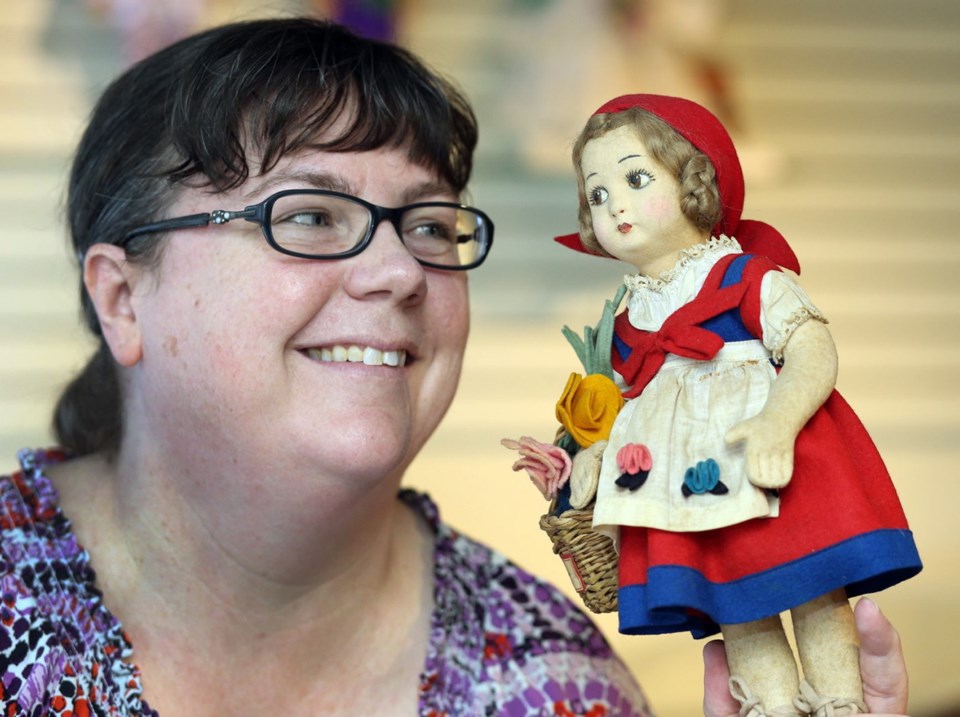What: Best-Loved Dolls of the Past 100 Years
When: Today through July 30
Where: Sidney Museum (2423 Beacon Ave.)
Tickets: By donation
Most little girls grow out of dolls, but Ginni Stieva never did.
That’s because the 46-year-old, who spends her days working in marketing communications, sees them as more than playthings: They’re windows into cultural history.
“They really demonstrate social change,” Stieva said. “If you look at that across time, you can see the social image of women and girls shift.”
Most of the 400 dolls in Sidney Museum’s new exhibition, The Best-Loved Dolls of the Past 100 Years, are on loan from Stieva’s personal collection. The oldest is an 1880s china-headed doll from Germany, covered in elaborate lace. The newest is still on store shelves: The part-supernatural dolls of Monster High.
For the most part, dolls have been designed in two categories, Stieva said. The “fashion” dolls taught girls from middle- and upper-class families about “social niceties.”
“You would have dolls with clothing that would reflect all the different situations that women were expected to function in,” she said, giving examples such as evening gowns and afternoon tea gowns.
“The idea was it would teach girls how to act in society.”
The other category is “baby” dolls, which conditioned girls as caregivers.
“Baby dolls were really intended to help girls think about caring for children, being careful and being nurturing,” she said.
Both fashion and baby dolls are still popular today. A significant shift occurred in the 1950s and 1960s, however, especially when Barbie entered the scene.
“Right around that era, you start to see dolls that have a life outside the home. They’re not just like, ‘OK, here’s the doll in her house dress and here’s the doll in her shop dress.’ Suddenly they have careers and activities and lives outside the house.”
Another trend is underway today, toward dolls less tied to the realities of existence.
The dolls from Monster High represent the offspring of famous monsters such as Dracula, while those from Ever After High are the sons and daughters of famous fairy-tale characters.
Still other dolls in Stieva’s collection tell stories of particular historical circumstances. The “Topsy-Turvy” doll — which can be transformed by flipping its skirt over its head to reveal a second head instead of legs and a differently patterned dress — was a hit during the Depression. It was essentially two toys in one.
Before Stieva began building a collection of her own, she had a role model to learn from. Her grandmother had a “doll room,” dedicated to her own collection. Stieva loved playing in the room lined with shelves of dolls, many of which wore clothes hand-sewn or repaired by her grandmother.
She was especially fond of a Shirley Temple doll sporting the iconic red and white polka-dot dress from Temple’s 1934 film Stand Up and Cheer.
“That experience with my grandmother really inspired my own collection. I actually have two Shirley Temple dolls of a similar era, but unfortunately not with the same outfit,” Stieva said.
Stieva still has a few of her grandmother’s dolls in her collection, but she began gathering her own as a child. The first one she bought herself was probably Superstar Barbie, who had “fabulous hair, a long, elegant, hot-pink dress and boa.”
She rounded out her collection more strategically as she got older, looking at dolls from a more historical perspective. A lull in collecting was overcome with the birth of her daughter 20 years ago, giving her a reason to buy more.
Stieva said her daughter is helping her set up the exhibit but doesn’t seem interested in carrying on the family tradition — yet.
“We’ll see if it infects her more significantly as she gets old,” Stieva said.
Visitors to the museum are invited to participate in three contests. The first is a doll-outfit designing contest (paper-doll outlines will be available). The second is a visual scavenger hunt, with a list of items to be discovered in the exhibition. Businesses on Beacon Avenue are participating in the third by putting dolls in their windows (contestants fill out an entry form listing the names of those businesses to compete).
The first 75 people who bring their American Girl dolls to the museum on June 21 will win a free gift. The same goes for those who bring Barbies on July 24.



